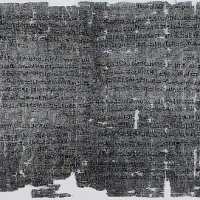[First posted November 2009, Revised 10 November 2011]
Even though ancient Egyptian art is replete with drawings of both banquets and crops – and even though tombs are filled with a variety of dried or preserved foods for use in the Afterlife – there are no recipes of how the food was cooked.
Banquet scenes show mounds of food – generally uncooked, except for loaves of bread and jugs of beer (see below photo):
Favorite cats, buried with their master, could also receive an offering table to the gods, or a banquet for the Afterlife – Engraving on the sarcophagus for a cat, tomb of King Tut
- Outside of a kitty-coffin, tomb of King Tut
I know, many websites will say that there are recipes from ancient Egypt, and may even give some, but these are either invented (albeit good-heartedly – after all, who wants to consider the grim fact that we really don’t know anything specific about ancient Egyptian cuisine?) – Or, the recipes are based on what is eaten in contemporary Egypt.
However, there are a number of prescriptions for use in curing various illnesses, which come very close to what we consider authentic recipes (i.e., ingredients are listed, together with method of preparation and of consumption). As well, the majority, as far as I’ve been able to ascertain, contain a variety of herbal ingredients.
Prescriptions are contained in several medical papyri, the most important being the Ebers and the Harris papyri, both of which were written in hieratic (a kind of hieroglyphic ‘shorthand’) on papyrus rolls. The Ebers, is dated to c. 1550 BC, and the Smith, to c. 1600 B.C.
The prescription below, which is to cure a urinary ailment, is from the Papyrus Ebers.
- A section of the Papyrus Ebers, written in hieratic. Source: Leipzig Univ.
Although there is no complete translation in English of the Papyrus Ebers, there is a collection of some of the prescriptions here, from which the following prescription for a urinary ailment is taken:
The English is not too clear; it says:
Another for correcting urine that (is in) excess: Cyperus grass, one; seeds grass, one; Root of bĥĥ shrub, one; beat into Consistency uniform, seep in beer sweet; Drink is along with the dregs a bowl of this.
This form is useful for students learning hieroglyphics (as I did a number of years ago) because – as here – the hieratic script (shown in the photo of the papyrus, above) is transcribed into hieroglyphics (shown directly above), and under each hieroglyph is written first, the transliteration – and under that, the translation.
Thus, The first word in the rubric:
= ‘kt’ > ‘Another’
(We don’t know what the short vowels were in ancient Egyptian because – as in Arabic – they are generally not written. Thus, ‘kt’ could have been pronounced kat, ket, kit, kut, etc…)
And so on…
Below, I have rendered the prescription into a more readable form, et voilà as close to an ancient Egyptian recipe as we’re likely to get! –
Ebers Papyrus – Rubric No. 264 (Column 49, Line 4)
Another [remedy] for correcting excess urine:
Ingredients: Cyprus grass 1 part Grass seeds 1 part Bĥĥ shrub roots [?] 1 part Method: Beat [grind] into a uniform consistency Seep into [a pot of] sweet beerPerhaps, an incontinent lady receiving the medicated brew to ease her distressTo be drunk along with the dregs in the bowl
(or, at least, provide some measure of pleasure by means of the beer). Source:Tomb of Rekhmire at Thebes (tomb 100).
If you would like to do a little more on learning hieroglyphics, there is a nice blog on the topic that I have just come across here.
Oh, and there are a few recipes for use in making perfumes and oils, and I will do another blog on that interesting topic.
Related articles
- History of Alchemy (bchq33.wordpress.com)
- Ancient History of Essential Oils (justjenn4u.wordpress.com)
- What do we get from ancient Egypt (wiki.answers.com)
- How Papyrus is Made (zwingliusredivivus.wordpress.com)




































Pingback: Nutsedge – perhaps the oldest managed ‘weed’ in Predynastic Egypt « Dianabuja's Blog
Very enjoyable post. I seem to remember reading about scholars who found hieroglyphic recipes for Egyptian beers, and of course brewsters have tried to make them. Ancient Egyptians loved beer. A friend of mine once told me about one of their beer poems: “Your eyes are like black beer, your skin is like beer foam.”
LikeLike
Thanks – haha! very good poem! Yes, several attempts have been made to recreate egyptian beer – harder than one might imagine!!
LikeLike
Steve – Put ‘beer’ into the search engine on my blog, and you’ll find several entries on making beer.
LikeLike
Pingback: 2010 in review – blog vital statistics from Wordpress « Dianabuja's Blog
Pingback: Most Popular Blog Pages – Why?! « Dianabuja's Blog
Susan – Thanks, and I very happy to have discovered your blog, which I’ve linked to this entry.
Maria – Yes, I like the idea of the exact ‘how’ of their cuisine remaining a mystery.
LikeLike
Great blog!
LikeLike
interesting linguistics and wonderful pictures
some things may have to remain a mystery, which makes them all the more alluring
LikeLike